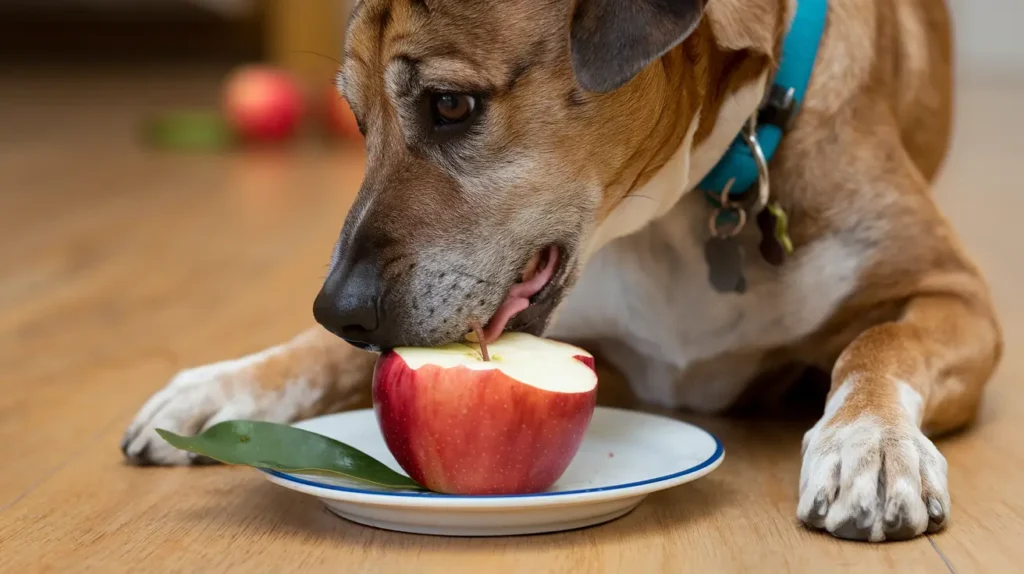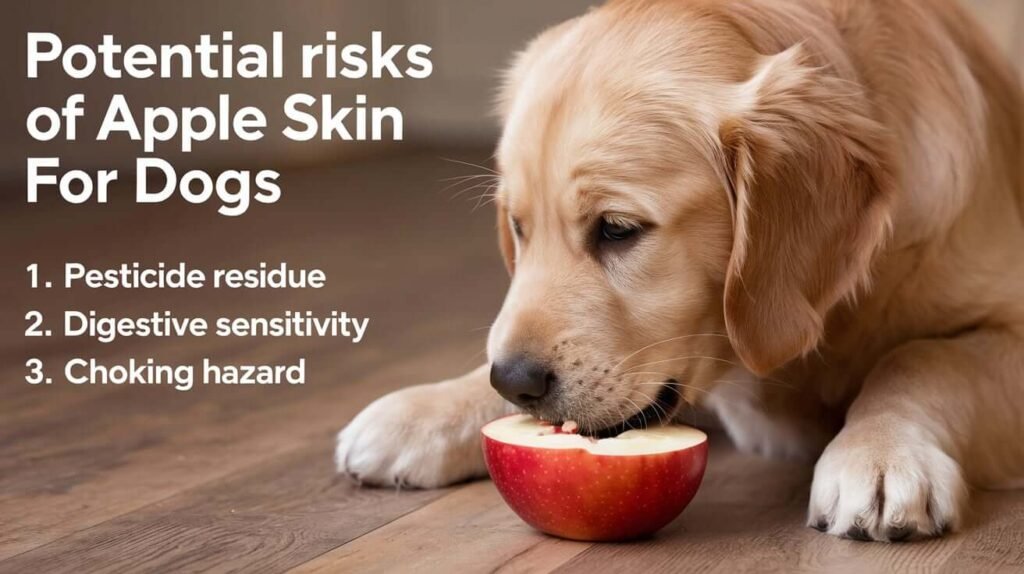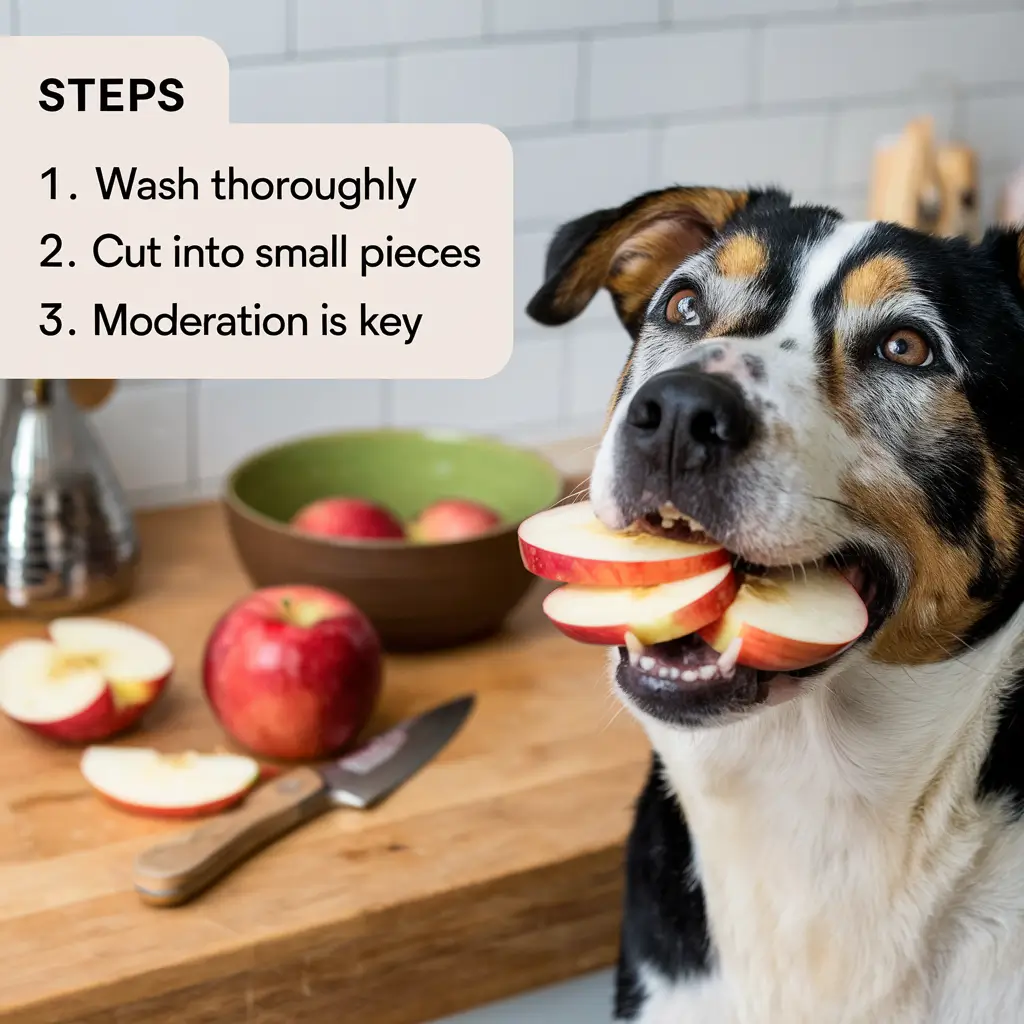Can Dogs Eat Apple Skin? 4 Impressive Nutritional Benefits
When it comes to treating our beloved canine companions to fresh fruits, many of us wonder about the safety of feeding specific parts, such as apple skin. In this detailed guide, we will answer the question, Can Dogs Eat Apple Skin? and discuss whether it’s safe for your dog to consume. We will also explore the nutritional benefits apple skin may offer and highlight any potential risks you should be aware of when adding this fruit to your dog’s diet.

Table of Contents
Can Dogs Eat Apple Skin? Nutritional Benefits of Apple Skin for Dogs
Apple skin is packed with various nutrients that can be beneficial to dogs. Here’s what makes apple skin appealing:
- Rich in Fiber: The skin of an apple contains a significant amount of dietary fiber. Fiber plays an essential role in a dog’s digestive health, helping to regulate bowel movements and support gut health. In moderation, apple skin can aid in digestion and prevent constipation.
- Vitamins and Antioxidants: Apple skin is loaded with vitamins like Vitamin A and Vitamin C, which are crucial for a dog’s overall well-being. Vitamin A supports vision and immune health, while Vitamin C is an antioxidant that helps fight inflammation and supports a healthy immune system.
- Phytochemicals and Flavonoids: Phytochemicals found in apple skin, such as quercetin, have anti-inflammatory and antioxidant properties. These compounds can provide added health benefits, such as reducing the risk of chronic diseases.
- Low Calorie: For dog owners who are conscious of their pet’s weight, apple skin is a low-calorie treat. It is a healthy option that won’t add unnecessary calories to a dog’s diet when given in moderation.
Potential Risks of Apple Skin for Dogs
While apple skin does have its advantages, it is essential to be mindful of the risks involved.
1. Pesticide Residue
One of the primary concerns with feeding dogs apple skin is the potential presence of pesticide residue. Apples are often sprayed with pesticides to keep them fresh and free from pests. Pesticide exposure could be harmful to your dog over time.
To minimize this risk, always wash apples thoroughly before offering them to your pet. If possible, opt for organic apples, which have lower pesticide levels.
2. Digestive Sensitivity
Some dogs have sensitive stomachs that may not tolerate apple skin well. The high fiber content, while generally beneficial, can lead to gastrointestinal upset in some dogs, especially if they are not used to consuming fiber-rich foods.
Symptoms like diarrhea or vomiting may occur if your dog consumes too much apple skin at once. Always start with small amounts to see how your dog reacts.
3. Choking Hazard
Apple skin can sometimes be tough and difficult to chew, especially for smaller dogs or those with dental issues. Ensure that the apple skin is cut into manageable pieces to prevent choking. Furthermore, it is vital to always supervise your dog when introducing new foods to their diet.

Can Dogs Eat Apple Skin? How to Safely Feed Apple Skin to Your Dog
To ensure that apple skin is a healthy and safe treat for your furry friend, consider the following guidelines:
1. Wash Thoroughly: As mentioned earlier, washing apples thoroughly can remove most of the pesticide residues. You can soak the apples in a mixture of water and a small amount of baking soda to effectively reduce pesticide levels.

2. Cut into Small Pieces: To prevent choking and make it easier for your dog to chew, slice the apple skin into small, bite-sized pieces. This is especially important for small breeds or older dogs.
3. Moderation is Key: Feeding apple skin in moderation is crucial. Too much fiber can upset your dog’s stomach. A few small pieces are generally safe for most dogs, but always monitor your dog for any adverse reactions.
Can Puppies Eat Apple Skin?
Puppies have delicate digestive systems, and caution is needed when offering them new foods. While small amounts of apple skin may be okay, it is better to consult your veterinarian before adding apple skin to your puppy’s diet. Gradually introduce the treat and observe for any digestive issues, such as diarrhea or bloating.
Are Apple Seeds Dangerous?
It’s important to note that while apple skin is generally safe, apple seeds are not. They contain amygdalin, which can release cyanide when digested. Cyanide is toxic to dogs and can be fatal in large quantities. Always remove the seeds and core from the apple before feeding any part of it to your dog, including the skin.
Can Dogs Eat Apple Skin in the Winter?
Yes, dogs can safely eat apple skin in the winter, as long as the apples are fresh and properly cleaned. The nutritional benefits of apple skin—such as fiber, vitamins, and antioxidants—remain valuable throughout the year, including during the winter season.
However, keep in mind that some dogs may become less active in the winter, which can affect their digestion. Be mindful of how much fiber you are adding to their diet, and adjust the portions accordingly to avoid any stomach upset. Additionally, always wash apples thoroughly to remove any potential pesticides or wax coatings.

Can Dogs Eat Apple Cores?
No, dogs should not eat apple cores. The core of an apple contains seeds, which are harmful to dogs. Apple seeds have a compound called amygdalin, which can release cyanide when digested. Cyanide is a highly toxic substance that can cause serious health problems, including difficulty breathing, seizures, or even death if consumed in large quantities.
Even though a few seeds may not cause immediate harm, it’s best to be safe and always remove the core and seeds before giving apples to your dog. Additionally, the apple core itself can be tough and pose a choking hazard, especially for small dogs.
Can Dogs Eat Apple Skin Every Day?
While dogs can eat apple skin, it’s best not to give it to them every day. Apple skin is rich in fiber and certain vitamins, which are beneficial in moderation. However, feeding it daily could lead to digestive problems, such as diarrhea or an upset stomach, due to the high fiber content. For most dogs, a few pieces of apple skin once or twice a week as a treat are perfectly fine.
Overfeeding fruits or fruit skins can also contribute to unnecessary calorie intake, which might lead to weight gain. Always remember to balance treats like apple skin with your dog’s regular, nutritionally complete diet and monitor for any signs of digestive discomfort.
Alternative Ways to Offer Apples to Your Dog
If you are unsure about feeding your dog apple skin or your dog doesn’t tolerate it well, there are alternative ways to include apples in their diet:
- Apple Slices Without Skin: Some dogs may digest peeled apple slices better. You can remove the skin and offer plain apple slices as a refreshing snack.
- Homemade Apple Treats: You can prepare dog-friendly treats using apples, such as apple and peanut butter biscuits (make sure the peanut butter is xylitol-free).
- Frozen Apple Cubes: During hot weather, frozen apple cubes can be a cooling treat for dogs. Simply dice apples into small chunks and freeze them.

When to Avoid Feeding Apple Skin to Your Dog
There are certain circumstances when it’s best to avoid feeding apple skin to your dog:
- Allergies or Food Sensitivities: If your dog has shown signs of food allergies or sensitivities, consult your veterinarian before introducing apple skin.
- Existing Health Conditions: Dogs with pre-existing health conditions like kidney disease or diabetes may need to avoid fruits high in sugar. Speak to your vet about whether apple skin is appropriate.
- Dental Issues: Dogs with poor dental health or missing teeth may struggle to chew apple skin properly. In such cases, opt for peeled apples or softer fruit alternatives.
Can Dogs Eat Apple Skin? Insights from Veterinary Research
Medical research and reputable sources in veterinary care affirm that dogs can safely consume apple skin in moderation. The skin of an apple contains beneficial nutrients such as vitamins A and C, antioxidants, fiber, and prebiotics, all of which promote various aspects of canine health. For example, the antioxidants in apple skin help combat free radicals and boost immune function, while the dietary fiber aids in healthy digestion.
However, there are precautions to consider. Apple skin should be thoroughly washed to remove any pesticides or contaminants before offering it to your dog. Additionally, excessive intake of apple skin may lead to digestive discomfort, such as diarrhea or constipation, due to the high fiber content Waldo’s Friends.

Veterinary guidance often emphasizes removing the core and seeds of the apple before feeding it to your dog. Apple seeds contain cyanogenic glycosides, which can release cyanide when chewed, posing a risk of toxicity, though significant poisoning is unlikely unless consumed in large quantities.
For more information on veterinary insights into feeding dogs fruits, consider exploring resources from veterinary schools or research published by organizations such as the University of California, Davis School of Veterinary Medicine or the American Veterinary Medical Association. For scientific studies and additional reading, you can visit reputable platforms like
Apple Skin in a Balanced Canine Diet
Incorporating apple skin as part of your dog’s diet requires careful consideration of their overall nutrition. Balance is crucial. Apple skin, while beneficial, should not replace the primary components of your dog’s meals, which should be high-quality dog food rich in protein, healthy fats, and essential nutrients. Treats like apple skin should make up no more than 10% of your dog’s daily caloric intake.
Monitoring Your Dog’s Reaction to Apple Skin
It’s essential to observe your dog after feeding them apple skin for the first time. Every dog is different, and some may have unpredictable reactions. Here’s what to watch out for:

1. Stomach Upset
Signs include diarrhea, vomiting, or excessive gas. If these occur, discontinue feeding apple skin and consult your veterinarian.
2. Allergic Reactions
Symptoms might include itching, swelling, or difficulty breathing. Though rare, it’s always better to be cautious and seek veterinary advice if an allergic reaction occurs.
3. Changes in Behavior
If your dog seems lethargic or behaves unusually after eating apple skin, it might indicate an intolerance or digestive issue.
Alternatives to Apple Skin for Dogs with Sensitivities
For dogs that do not tolerate apple skin well, there are plenty of other healthy fruit and vegetable options. Here are a few alternatives:
- Carrot Sticks: Crunchy and full of beta-carotene, carrots are a great treat for dogs and are easy to digest.
- Blueberries: These small, antioxidant-rich fruits are perfect for a quick, nutrient-dense snack.
- Watermelon (Seedless): Hydrating and full of vitamins, watermelon is a safe and refreshing treat. Be sure to remove the seeds and rind.
- Cucumbers: Low in calories and packed with vitamins, cucumbers are a safe option, especially for dogs needing to lose weight.
Tips for Preparing Apple Skin Safely for Dogs
- Use a Fruit and Vegetable Wash: For additional safety, consider using a natural fruit and vegetable wash to clean apples thoroughly before feeding.
- Organic Apples Are Best: When possible, choose organic apples to reduce the risk of pesticide exposure.
- Mix Apple Skin with Other Foods: If your dog is hesitant to eat apple skin on its own, try mixing small pieces with their regular kibble or a spoonful of plain, unsweetened yogurt.
Homemade Apple-Based Dog Treat Recipes
For dog owners who love making homemade treats, here are some simple recipes using apples:
1. Apple and Oat Treats
- Ingredients: 1 apple (cored and chopped), 1 cup of oats, 1 egg.
- Instructions: Blend the apple pieces and oats until a thick mixture forms. Add the egg and mix well. Form small balls and bake at 350°F for 15 minutes or until firm. Let cool and serve as a crunchy snack.

2. Frozen Apple and Yogurt Bites
- Ingredients: 1 apple (peeled and chopped), plain unsweetened yogurt.
- Instructions: Mix apple pieces with yogurt and spoon into an ice cube tray. Freeze for a few hours and serve as a refreshing summer treat.
3. Apple and Peanut Butter Biscuits
- Instructions: Mix the chopped apple, peanut butter, and flour. Slowly add water until a dough forms. Roll out the dough and cut into shapes. Place on a baking sheet and bake at 350°F for 20-25 minutes or until golden. Let cool before serving.
- Ingredients: 1 apple (cored, peeled, and finely chopped), 1/4 cup unsalted, xylitol-free peanut butter, 2 cups whole wheat flour, 1/4 cup water.
4. Apple and Carrot Chews
- Ingredients: 1 apple (grated), 1 carrot (grated), 2 cups brown rice flour, 1/4 cup water.
- Instructions: Combine grated apple and carrot with the flour. Gradually add water to form a dough. Shape into small sticks or chews and bake at 325°F for 30 minutes or until firm. Cool completely before giving to your dog.
5. Apple Cinnamon Dog Muffins
- Ingredients: 1 apple (peeled and diced), 1/2 teaspoon ground cinnamon, 1 cup oat flour, 1 egg, 1/4 cup unsweetened applesauce.
- Instructions: Mix diced apple, cinnamon, oat flour, egg, and applesauce. Pour into mini muffin tins and bake at 350°F for 15-20 minutes. Let muffins cool before serving as a tasty snack.
6. Apple and Sweet Potato Treats
- Instructions: Blend chopped apple and sweet potato until smooth. Mix with rice flour to form a dough. Roll out and cut into desired shapes. Bake at 350°F for 25 minutes or until treats are hard. Allow to cool thoroughly.
- Ingredients: 1 apple (peeled and chopped), 1 medium sweet potato (cooked and mashed), 1 1/2 cups rice flour.

Final Thoughts: Can Dogs Eat Apple Skin?
Apple skin can be a nutritious and enjoyable treat for many dogs, provided it is introduced with care and moderation. The key to ensuring your pet benefits from this healthy snack lies in taking a few crucial precautions. First, always wash apples thoroughly to minimize the risk of pesticide exposure. Organic apples are ideal if available, as they typically have fewer pesticide residues.
Choking hazards are another critical concern. Always remove the apple core and seeds, as they not only present a choking risk but also contain toxic compounds that can be harmful to dogs. Cutting the apple skin into small, manageable pieces is also a great practice, especially for smaller breeds or dogs prone to gulping their food.
Digestive sensitivity is also worth monitoring. Some dogs may experience gastrointestinal upset, such as diarrhea or gas, from the fiber content of apple skin. Always introduce new foods slowly and observe your dog’s reaction. If your dog seems to tolerate apple skin well, it can be a delightful, nutrient-rich addition to their treat rotation.
Lastly, when introducing any new food to your dog’s diet, it’s best to consult your veterinarian. They can offer personalized guidance, especially if your dog has existing health issues or specific dietary restrictions. While apple skin can offer many benefits, such as improved gut health from natural prebiotics and essential vitamins like A and C, every dog is different, and what works well for one may not suit another.
By following these guidelines, apple skin can be a tasty and healthful way to add variety to your dog’s diet, ensuring they enjoy all the benefits without unwanted side effects.
FAQs About Feeding Apple Skin to Dogs
Is Apple Skin Nutritious for Dogs?
Yes, apple skin contains fiber, vitamins, and antioxidants that can be beneficial for your dog. However, it’s essential to serve it in moderation as part of a balanced diet. Make sure to wash the apple thoroughly to remove any pesticide residues.
Can Apple Skin Cause Digestive Issues in Dogs?
Apple skin can sometimes cause digestive issues like bloating or diarrhea, especially in dogs with sensitive stomachs or if given in excess. Always introduce it gradually to see how your dog reacts.
What Should I Do if My Dog Accidentally Eats Too Much Apple Skin?
If your dog consumes a large amount of apple skin, monitor them for signs of digestive upset, such as vomiting, diarrhea, or abdominal discomfort. If symptoms persist, consult your vet.
How Should I Prepare Apple Skin for My Dog?
Make sure the apple is thoroughly washed and free of any seeds or core, as these parts contain cyanide compounds that are harmful to dogs. You can slice the apple thinly, ensuring it’s easy for your dog to chew.
Is Organic Apple Skin Better for Dogs?
Yes, organic apples are preferable if you’re feeding your dog apple skin since they are grown without synthetic pesticides. However, always wash any apple before serving it to your dog.
Can Apple Skin Help with My Dog’s Bad Breath?
Chewing on apple skin can help clean your dog’s teeth naturally, reducing plaque buildup, which may contribute to fresher breath. However, apple skin should not replace regular dental care.







